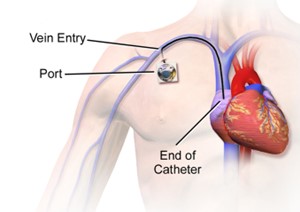Following surgery, a patient's central venous pressure (CVP) monitor indicates high pressures. Which action will the nurse anticipate taking?
Increase the IV fluid infusion rate.
Administer IV diuretic medications.
Elevate the head of the patient's bed to 45 degrees.
Document the CVP and continue to monitor.
The Correct Answer is B
Central venous pressure (CVP) is a measurement of the pressure in the central veins, which reflects the blood volume and right-sided cardiac function. High CVP readings may indicate fluid overload or impaired cardiac function, and intervention is necessary to address the underlying cause.
Administering IV diuretic medications can help reduce fluid volume by increasing urine output and promoting fluid elimination. By removing excess fluid, the diuretic medications can help lower the CVP and alleviate the high pressures.
The other options mentioned are not the anticipated actions for addressing high CVP:
A. Increasing the IV fluid infusion rate in (option A) is incorrect because: If the CVP is already indicating high pressures, increasing the IV fluid infusion rate would further contribute to fluid overload and exacerbate the problem. This action would not be appropriate for high CVP readings.
C. Elevating the head of the patient's bed to 45 degrees in (option C) is incorrect because Positioning the patient with the head of the bed elevated is commonly done to prevent complications such as aspiration or improve respiratory function. While it may have other benefits, it does not directly address the high CVP.
D. Documenting the CVP and continuing to monitor in (option D) is incorrect because Documenting the CVP and continuing to monitor is important for ongoing assessment and evaluation. However, in the presence of high CVP readings, intervention is necessary to address the underlying issue rather than solely documenting and monitoring.
Therefore, when a patient's CVP monitor indicates high pressures following surgery, the nurse would anticipate administering IV diuretic medications to help reduce fluid volume and lower the CVP.

Nursing Test Bank
Naxlex Comprehensive Predictor Exams
Related Questions
Correct Answer is B
Explanation
Assessing tissue perfusion is crucial in evaluating the adequacy of oxygen and nutrient delivery to the body's tissues. While multiple factors contribute to tissue perfusion, the options provided in choice B are key indicators:
Level of consciousness: Altered mental status or changes in the patient's level of consciousness can be a sign of impaired cerebral perfusion, which reflects overall tissue perfusion.
Urine output: Monitoring urine output provides information about renal perfusion and kidney function. Decreased urine output can be indicative of inadequate tissue perfusion.
Lactate level: Lactate is a by-product of anaerobic metabolism that accumulates when there is insufficient oxygen delivery to tissues. Elevated lactate levels indicate tissue hypoperfusion and cellular oxygen debt.
A. Pupil response, pulse pressure, and urine output in (option A) are incorrect because While pupil response and pulse pressure may provide some information about perfusion, they do not encompass a comprehensive assessment of tissue perfusion. Additionally, assessing urine output is important, but it alone may not provide a complete picture of tissue perfusion status.
C. Blood pressure, pulse, and respirations in (option C) are incorrect because Blood pressure, pulse, and respirations are important vital signs to monitor, but they do not solely indicate tissue perfusion. Hypotension, for example, can be a late sign of inadequate tissue perfusion.
D. Breath sounds, heart rate, and pupil response in (option D) are incorrect because: Although breath sounds and heart rate can be affected by changes in tissue perfusion, they are not specific or comprehensive indicators of tissue perfusion status. Pupil response alone does not provide a complete assessment of tissue perfusion.
Therefore, the most accurate assessment of tissue perfusion in a patient in shock involves evaluating the level of consciousness, urine output, and lactate levels.
Correct Answer is C
Explanation
Heart rate: 72 beats per minute Stroke volume: 90 mL/contraction
Cardiac output = Heart rate × Stroke volume
Cardiac output = 72 beats/minute × 90 mL/contraction
To simplify the calculation, you can convert the units:
72 beats/minute × 90 mL/contraction = (72 × 90) beats/minute × mL/contraction
Now, perform the multiplication:
72 × 90 = 6,480
Therefore, the cardiac output is 6,480 mL per minute.
The correct answer is:
C. 6,480 mL
Whether you are a student looking to ace your exams or a practicing nurse seeking to enhance your expertise , our nursing education contents will empower you with the confidence and competence to make a difference in the lives of patients and become a respected leader in the healthcare field.
Visit Naxlex, invest in your future and unlock endless possibilities with our unparalleled nursing education contents today
Report Wrong Answer on the Current Question
Do you disagree with the answer? If yes, what is your expected answer? Explain.
Kindly be descriptive with the issue you are facing.
